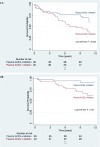Elevated plasma angiotensin converting enzyme 2 activity is an independent predictor of major adverse cardiac events in patients with obstructive coronary artery disease
- PMID: 29897923
- PMCID: PMC5999069
- DOI: 10.1371/journal.pone.0198144
Elevated plasma angiotensin converting enzyme 2 activity is an independent predictor of major adverse cardiac events in patients with obstructive coronary artery disease
Abstract
Background: Angiotensin converting enzyme 2 (ACE2) is an endogenous regulator of the renin angiotensin system. Increased circulating ACE2 predicts adverse outcomes in patients with heart failure (HF), but it is unknown if elevated plasma ACE2 activity predicts major adverse cardiovascular events (MACE) in patients with obstructive coronary artery disease (CAD).
Methods: We prospectively recruited patients with obstructive CAD (defined as ≥50% stenosis of the left main coronary artery and/or ≥70% stenosis in ≥ 1 other major epicardial vessel on invasive coronary angiography) and measured plasma ACE2 activity. Patients were followed up to determine if circulating ACE2 activity levels predicted the primary endpoint of MACE (cardiovascular mortality, HF or myocardial infarction).
Results: We recruited 79 patients with obstructive coronary artery disease. The median (IQR) plasma ACE2 activity was 29.3 pmol/ml/min [21.2-41.2]. Over a median follow up of 10.5 years [9.6-10.8years], MACE occurred in 46% of patients (36 events). On Kaplan-Meier analysis, above-median plasma ACE2 activity was associated with MACE (log-rank test, p = 0.035) and HF hospitalisation (p = 0.01). After Cox multivariable adjustment, log ACE2 activity remained an independent predictor of MACE (hazard ratio (HR) 2.4, 95% confidence interval (CI) 1.24-4.72, p = 0.009) and HF hospitalisation (HR: 4.03, 95% CI: 1.42-11.5, p = 0.009).
Conclusions: Plasma ACE2 activity independently increased the hazard of adverse long-term cardiovascular outcomes in patients with obstructive CAD.
Conflict of interest statement
The authors have declared that no competing interests exist.
Figures

References
-
- Benjamin EJ, Blaha MJ, Chiuve SE, Cushman M, Das SR, Deo R, et al. Heart Disease and Stroke Statistics-2017 Update: A Report From the American Heart Association. Circulation. 2017;135(10):e146–e603. doi: 10.1161/CIR.0000000000000485 - DOI - PMC - PubMed
-
- Oudit GY, Crackower MA, Backx PH, Penninger JM. The role of ACE2 in cardiovascular physiology. Trends Cardiovasc Med. 2003;13(3):93–101. - PubMed
-
- Tesanovic S, Vinh A, Gaspari TA, Casley D, Widdop RE. Vasoprotective and atheroprotective effects of angiotensin (1–7) in apolipoprotein E-deficient mice. Arterioscler Thromb Vasc Biol. 2010;30(8):1606–13. doi: 10.1161/ATVBAHA.110.204453 - DOI - PubMed
-
- Donoghue M, Hsieh F, Baronas E, Godbout K, Gosselin M, Stagliano N, et al. A novel angiotensin-converting enzyme-related carboxypeptidase (ACE2) converts angiotensin I to angiotensin 1–9. Circ Res. 2000;87(5):E1–9. - PubMed
-
- Lambert DW, Yarski M, Warner FJ, Thornhill P, Parkin ET, Smith AI, et al. Tumor necrosis factor-alpha convertase (ADAM17) mediates regulated ectodomain shedding of the severe-acute respiratory syndrome-coronavirus (SARS-CoV) receptor, angiotensin-converting enzyme-2 (ACE2). J Biol Chem. 2005;280(34):30113–9. doi: 10.1074/jbc.M505111200 - DOI - PMC - PubMed
Publication types
MeSH terms
Substances
LinkOut - more resources
Full Text Sources
Other Literature Sources
Medical
Research Materials
Miscellaneous

